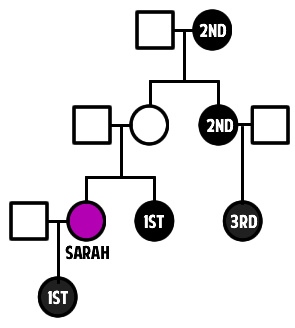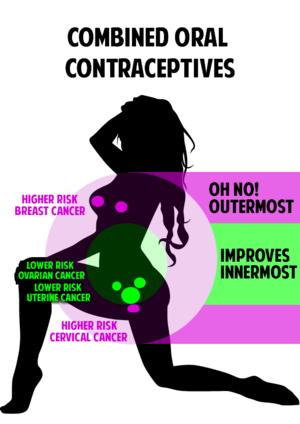NICE summaries

The purpose of this page is to allow you to quickly brush up on the relevant NICE guidance in common areas, split up by common topics body system/pathologies. Try to memorise them all in one sitting (really - don't do this)...
Cancer is a huge topic, affecting every organ system, so I've dropped the guidance into each sub section...
Cardiovascular
AF
Atrial fibrillation is very common. If they are haemodynamically stable, then you want to do an ECG to confirm. Once confirmed, consider starting anticoagulation, and think about Rate/Rhythm control.
Anticoagulation
Do a CHA2DS2Vasc. Try the free online tool, or calculate yourself:
| CHA2DS2Vasc | Score |
|---|---|
| CCF | 1 point |
| Hypertension | 1 point |
| Age (more than 65) | 1 point |
| (or if more than 75) | 2 points |
| Diabetes | 1 point |
| Stroke | 2 points |
| Vascular
Disease |
1 point |
The proper tool has a point for gender too, but that needlessly confuses things with the guidance. Ignore gender, and anyone that scores 2 or more needs to be considered for anticoagulation.
You then do a HASBLED score, which tells you their risk of bleeding. Score 3 or more, and it becomes less sensible to start warfarin.
| HASBLED | Score |
|---|---|
| Hypertension | 1 |
| Age (65+) | 1 |
| Stroke | 1 |
| Kidney issues | 1 |
| Knackered liver | 1 |
| Unstable INR | 1 |
| Alcohol use | 1 |
You then start them on Warfarin. You can definitely also consider a NOAC, they appear to be pretty equally good.
Rhythm Control
If fits the criteria below, then refer for cardioversion. (Will need warfarinisation before cardioversion for at least 4 weeks.)
- New onset AF
- AF with reversible cause
- Heart failure suspected to be caused by AF
Rate Control
Most people - your standard 70 year old with an incidental finding of AF on examination - will need rate control. You want to:
- Keep pulse under 100.
- Start with bisoprolol.
- Consider adding in diltiazem or digoxin if not working.
- Still struggling? Refer.
Chest Pain
Medical Emergency - Likely acute coronary syndrome with active chest pain will need sending to hospital by ambulance.
You need to give them:
- GTN
- Aspirin 300mg
- Do an ECG
- Measure O2 saturation, consider giving oxygen.
If they have no pain currently, but have had within the last 72 hours, will likely still need to go to hospital for ECG and Troponin.
Stable chest pain
Assess them, looking for cardiac risk factors, especially diabetes, smoking and hyperlipidaemia.
For most of them, you will want to do further tests to identify likelihood of angina. This will often be an exercise ECG, myocardial perfusion scan or similar. Either way, best access route is usually rapid access chest pain clinic.
Managing angina[1]
Once you've confirmed angina, manage it with:
- GTN spray
- Lifestyle interventions
- Beta blocker (or calcium channel blocker)
- Aspirin 75mg
- Statin - atorvastatin 80mg.
- ACE inhibitor if they have diabetes
Familial hypercholesterolaemia[2]
Dermatology
Endocrine
Diabetes
Eyes and ENT
Geriatrics
GI
Upper GI cancer
You will want to refer via 2WW anyone with an upper abdominal mass that suggests stomach cancer, or anyone over 40 with jaundice.
Send for urgent OGD
- Dysphagia
- 55+ with weight loss and pain/reflux symptoms.
Send for non-urgent OGD
- Haematemesis
- 55+ with:
- Non resolving dyspepsia.
- Upper abdo pain and anaemia
- Raised platelets with any upper GI symptoms
- Nausea and vomiting with weight loss/reflux/pain
Send for urgent CT
Anyone who is 60+ with weight loss and any of these:
- Diarrhoea or constipation
- Back pain
- Abdominal pain
- Nausea/Vomiting
- New diabetes
Some of these are a bit odd, because you would probably already be sending on a Lower GI cancer referral...
Consider urgent USS
Anyone who has a mass that feels like an enlarged liver or gallbladder mass deserves a cheeky USS.
Lower GI cancer
It's 2WW time for any of the following:
- Any age with unexplained anal mass or ulceration.
- 40+ with weight loss and abdo pain
- 50+ with unexplained rectal bleeding
- 60+ with iron deficiency anaemia or changes in bowel habit.
- Positive FOB test.
Consider 2WW referral
- Any abdominal mass
- Younger than 50 with rectal bleeding plus:
- Abdominal pain
- Change in bowel habit
- Weight loss
- Iron deficiency anaemia
Offer FOB testing
- 50+ with abdominal pain +/- weight loss.
- Less than 60 with change in bowel habit or iron deficiency anaemia.
- More than 60 with any anaemia.
Gynaecology
Ovarian cancer
You need to refer urgently if you suspect ascites, or find any unexpected pelvic/abdominal mass.
Consider ovarian malignancy and do CA125 if
- 50+ woman with bloating, early satiety, pelvic pain, or increased urinary symptoms.
- Any unexplained weight loss, fatigue or bowel habit changes.
- New onset of IBS in women over 50.
The key is that ovarian cancer is easily missed and diagnosed late, so always have it at the back of your mind.
Endometrial cancer
Send anyone 55+ with postmenopausal bleeding via 2WW. Consider it strongly in anyone under 55 too.
Go for an urgent USS if...
- 55+ with unexplained vaginal discharge for the first time, or with thrombocytosis, or with haematuria.
- Haematuria with anaemia, raised platelets or high blood sugars.
Other gynae cancers
If the cervix is abnormal in appearance, they are going to need an urgent referral. Same with any weird vulval lumps, ulcers or bleeding.
Haematology
Leukaemia
Do an FBC within 48 hours in any children or adults with one of these:
- severe pallor or tiredness
- generallised lymphadenopathy
- unexplained persistent infections
- bleeding or bruising issues
- hepatosplenomegaly
In children with these bleeding or bruising issues or hepatosplenomegaly, admit for an immediate specialist review - they coiuld have severe marrow suppression!
Lymphoma
Refer anyone with unexplained lymphadenopathy or splenomegaly for 2WW. Refer kids even more urgently. Especially think about fever, night sweats, SOB, itchiness, weight loss.
Myeloma
In patients over 60 with bone pain, particularly back pain or unexplained fractures do FBC, serum calcium and ESR/plasma viscosity.
If they have raised calcium, or raised viscosity, do protein electrophoresis and Bence Jones protein urine test within 48 hours. Refer with 2WW if these suggest myeloma.
Immunisations
Lifestyle
Obesity
Smoking
Mental Health
Musculoskeletal
Neurology
Brain and CNS cancer
Adults with a progressive loss of CNS functions, or any sign of intracranial lesion should have an urgent MRI. Children should have an urgent Neurology review.
Paeds
Childhood cancers
All the below need a 2WW referral to rule out neuroblastomas, retinoblastomas and Wilm's tumours...
- Palpable abdominal mass
- Absent red reflex
- Unexplained visible haematuria
Respiratory
Lung cancers
In
anyone with a suggestive CXR, or anyone over 40 with unexplained haemoptysis you need to refer them through 2WW.
Otherwise, consider:
Urgent CXR if over 40 and 2 of these:
- Significant smoking/asbestos history
- Cough
- Fatigue
- SOB
- Chest pain
- Weight loss or loss of appetite
Consider urgent CXR if over 40 and
Anything weird, such as recurrent chest infections, clubbing, neck or supraclavicular lymphadenopathy or weird chest findings on examination.
Sexual Health
Contraception
UKMEC guidance says the combined pill should be avoided in anyone:
- 35+ who smokes
- BMI over 35
- Breastfeeding, or within 3 weeks of giving birth.
- High blood pressure or vascular disease
- History of DVT (or high risk for one)
- With previous stroke
- Migraine with aura.
- Personal history of breast cancer, or BRCA1 positive.
- Diabetes with end organ damage.
- Liver cancer
- Current gall bladder disease.
- Lupus
Cancer risk
The Combined Oral Contraceptive increases risk of some female cancers. The easy way to remember risk: Oral = Oh no!
Oh no! Outermost, Improves Innermost:
- Increases risk of outermost female cancers - breast and cervical
- Decreases risk of innermost - ovarian and endometrial
Pregnancy
Urology
Male Stuff
Refer any of the following via 2WW:
- Lumpy scary-feeling prostate on DRE.
- PSA above the age specific range (Generally anything much over 5).
- Painless enlargement or change in testicle shape.
- Firm penile mass or ulceration after STI excluded/treated.
Consider DRE and PSA test
- Any urinary symptoms, such as urgency, frequency, nocturia, etc.
- Erectile dysfunction
- Visible haematuria
Exclude UTI with these too.
Consider USS
- For any unexplained or unusually persistent testicular symptoms.
Bladder and kidney cancer
Two groups to look for:
- 45+ with visible haematuria without UTI as the cause
- 60+ with microscopic haematuria and dysuria or raised WCC.
Consider non urgent referral
Anyone over 60 with recurrent UTI with no obvious cause.
Women's Health
Breast cancer
Breast clinic under a 2WW for anyone:
- Over 30 with a concerning breast lump with or without pain.
- 50+ with nipple changes or discharge.
Consider 2WW referral for anyone
- With skin changes that suggest breast cancer
- 30+ with axillary lump with no obvious cause.
Clinical Genetics referral

First step is to understand what a first, second and third degree relative is - its simply just the number of steps from you along a family tree:
- First degree: parents, siblings, children
- Second degree: grandparents, aunts, nephew, grandchild, half-sibling, etc
- Third degree: great-grandparents, great aunt/uncle, first cousin, great grandchild, great niece or great nephew
Refer to Clinical Genetics if breast cancer in:
- any 1st degree female relatives under age of 40
- any 1st degree male relatives at any age
- any two 1st and 2nd degree relatives
- any three 1st, 2nd and 3rd
- any 1st or 2nd with breast plus any 1st or 2nd with ovarian cancer
References
- ↑ NICE on the management of stable angina - NICE 2011, CG126 https://www.nice.org.uk/guidance/cg126/chapter/1-Guidance : Last accessed 28/1/2016
- ↑ NICE Familial Hypercholesterolaemia Guidelines - NICE 2008, CG71 - https://www.nice.org.uk/guidance/cg71/chapter/1-Guidance : Last accessed ~~~~~
